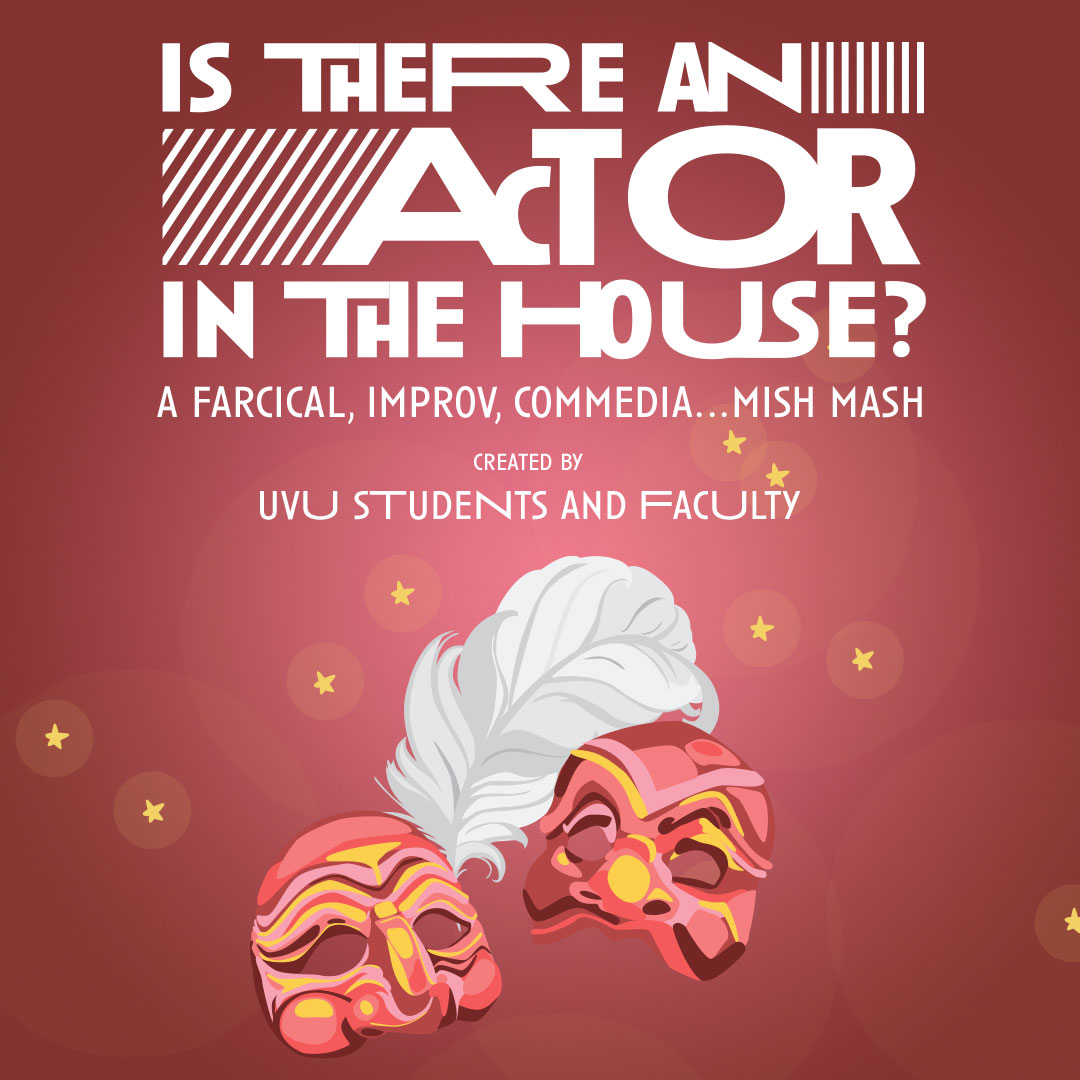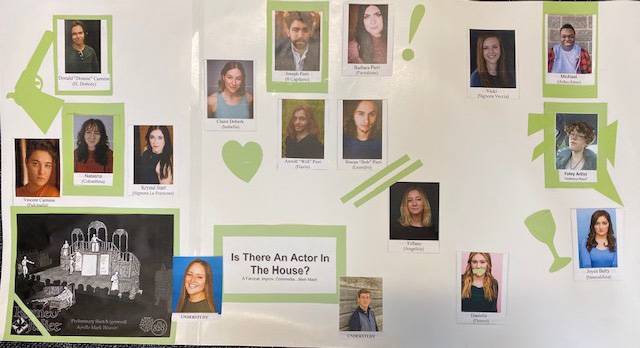
Bastian Theatre
November 11 - 19, 2022 | 7:30 p.m.
Written and Directed by
Laurie Harrop-Purser
Tristin Juarez-Smith
Apollo Weaver
Mary Pobanz
La Beene
Michelle Walling
Lillian Hanks
Madison Halverstadt
Graham Whipple
Andrew Domyan
Ele Rose
Janine Sobeck Knighton
Maisie Bunker Nelson
Kim Abunawara
Jennifer Delac
Kathy Curtiss
Devon Parikh
Sam Brockman
Stevie Rimke
IAN PURSER
CALEB VOSS
ALICE ELLSWORTH
CAROLINE CLAWSON
JACOB THOMASON
ERICA SCHOEBINGER
ADDIE WRAY SCOTT
DESMOND WALKER
JONATHAN FRANCIS
ABBY HAWS
MAKENNA ASHBY
DAVID VAN FRANKENHUIJSEN
KALENA NIELSON
KEELY CONRAD
CASEY COPIER
MYA ODOM
MYA ODOM
Production Assistant
Nathan Lowry
Production Assistant
Elizabeth Sosa
Deck Hands
Props Supervisor
Wardrobe Supervisor
Dresser
Wardrobe Swing
Light Board Operator
Spotlight Operator
Sound A1
Sound A2
Makeup Supervisor
Sound Swing
Tech
Scenic and Sound Design Faculty Mentor
Graham Whipple
Costume & Makeup Design Faculty Mentor
La Beene
Stage Manager Mentor
Jennifer Delac
Is There An Actor in the House: A Farcical, Improv, Commedia…Mish Mash is a completely original story from the mind of playwright and director Laurie-Harrop
Purser. Learn more about her inspirations, her process, and her challenges in the
interview below.
Janine Sobeck Knighton:Where did the idea for the play come from?
Laurie-Harrop-Purser: This play came from a need for a script. Originally, we were going to do a script
that had a lot of movement – that was largely story-plot, movement, with some music
– based. We found, however, that this script had elements that were not supportive
of our BIPOC community. So we needed a different play that met all of these criteria.
We didn’t find the one we wanted so several people told me to do a Commedia piece
– lots of movement, had an improv element which is something that I like doing, and
had a possibility of a musical element. I thought that putting Commedia (specifically
the archetypal characters), Farce (specifically the physical and verbal comedy), and
Improv together would be an interesting challenge and a growth process for the students.
JSK:What was your process in developing the story?
LHP: So – no script….but some archetypal characters for the Commedia…AND a desire to give
a lot of students the experience to work with these genre’s. I put together an audition
with Improv elements, physical comedy elements, and broad physical character elements. Then,
I had someone else cast my show. She cast of group of 17 students – 3 opted out over
the next month and so we ended up with 14 students.
Once I had a cast, the first thing I did was create an outline of the genre’s that
I wanted to use:
Act I scene I Farce – set up of why we are doing a show within a show.
Act I Scene II – Commedia Show – which would be an outline of a story with Improv and Musical Improv elements.
Act II – Going back to Farce, with a behind-the-scenes look at what happened backstage during the Commedia show.
Act III – Farce and Commedia combined.
So then I had to write a show that fit those genre specific scenes, and I created characters from the actor’s themselves – which was incredibly fun! I worked from what they were good at and also what I wanted them to work on!

The poster with pictures of all the cast members and their parts that Laurie used
for inspiration during the writing process.
JSK: What was one of your favorite characters to write?
LHP: The character Krystal was written for an actress who is so talented but not always
as outspoken and loud as I would love to see her be on stage, so I make her character
really specific and out there. I loved writing this character.
JSK: What is one piece of advice you would give to someone who wants to create theatre?
LHP: My advice? CAST FEWER PEOPLE!!! This has been so hard.
One of the major elements of a commedia dell’arte show is improv! This means that
there is a general outline of the story, but the actors are making up the dialogue.
Our director Laurie Harrop-Purser teaches improve and runs UVU’s Improv Team (You can check them out here!) and here are her top 10 tips for anyone who’d like to give it a try!
1. LISTEN! Slow down and LISTEN!
2. Yes – And: is what you always hear is the first rule of Improv. Saying YES, is
accepting the world of the play that your scene partner gives you. AND is offering
something that gives your scene partner something to play with.
3. Remember what a scene needs. Relationship, where are we, objective, complicating the objective.
4. Play at a real life level – it’s funnier. Goblins and Aliens themselves aren’t
funny. But Goblins who are worried about relationships or bad breath….is funny.
5. Be honest.
6. Be aware of what your audience sees. If you walk through a table that is established
…your audience sees that. So you have to address it.
7. Start in the middle of a scene…don’t say hi, how are you. It takes forever to
get into a scene that way. Say, “He proposed to you on the first date?” Or, “There
are 10 of them out there right now!” Or, “I don’t think final exams are necessary.”
Start in the middle.
8. Specificity: Don’t just say you are at a restaurant, say the balls from the play
pit are all over the floor at this McDonalds in Lehi, Utah.
9. Use your whole body. Create tasks in the where.
10. Don’t “be funny!” Be present and serve the scene!

The Kennedy Center American College Theater Festival is sponsored by the U.S. Department of Education; Dr. Gerald and Paula McNichols Foundation; The Honorable Stuart Bernstein and Wilma E. Bernstein; the Kennedy Center Corporate Fund; and the National Committee for the Performing Arts.
This production is entered in the Kennedy Center American College Theater Festival (KCACTF). The aims of this national theater education program are to identify and promote quality in college-level theater production. To this end, each production entered is eligible for a response by a regional KCACTF representative, and selected students and faculty are invited to participate in KCACTF programs involving scholarships, internships, grants and awards for actors, directors, dramaturgs, playwrights, designers, stage managers and critics at both the regional and national levels.
Productions entered on the Participating level are eligible for inclusion at the KCACTF regional festival and can also be considered for invitation to the KCACTF national festival at the John F. Kennedy Center for the Performing Arts in Washington, DC in the spring of 2011.
Last year more than 1,300 productions were entered in the KCACTF involving more than 200,000 students nationwide. By entering this production, our theater department is sharing in the KCACTF goals to recognize, reward, and celebrate the exemplary work produced in college and university theaters across the nation.
Utah Valley University acknowledges that we gather on land sacred to all Indigenous people who came before us in this vast crossroads region. The University is committed to working in partnership—as enacted through education and community activities—with Utah’s Native Nations comprising: the San Juan Southern Paiute, Paiute Indian Tribe of Utah, Uintah & Ouray Reservation of the Northern Ute, Skull Valley Goshute, Confederated Tribes of the Goshute Reservation, Northwestern Band of Shoshone Nation, Hopi Tribe, Navajo Nation, Ute Mountain Ute-White Mesa Community, and urban Indian communities. We recognize these Native Nations and their continued connections with traditional homelands, mountains, rivers, and lakes as well as their sovereign relationships with state and federal governments. We honor their collective memory and continued physical and spiritual presence. We revere their resilience and example in preserving their connections to the Creator and to all their relations, now and in the future.
With this statement comes responsibility and accountability. We resolve to follow up with actionable items to make the School of the Arts at UVU and The Noorda Center for the Performing Arts an inclusive, equitable, and just space for all. There is much work to be done, and we are committed to putting these words into practice.
Chair, Associate Professor
LA BEENE, MFA
Associate Chair, Associate Professor
JULIE HEATON, MFA
Administrative Assistant
CURTIS CLUFF, MFA
Associate Professor
AMANDA CRABB, MM
Assistant Professor
JENNIFER DELAC, MFA
Lecturer
ELIZABETH GOLDEN, MFA
Lecturer
M. CHASE GRANT, MFA
Professor
LISA HALL, PHD
Professor
LAURIE HARROP-PURSER, MFA
Lecturer
SHANNON HUTCHINS, MFA
Assistant Professor
RICHARD LORIG, MFA
Professor
JOHN NEWMAN, PHD
Assistant Professor
STEVEN RIMKE, MFA
Lecturer
GRAHAM WHIPPLE, MFA